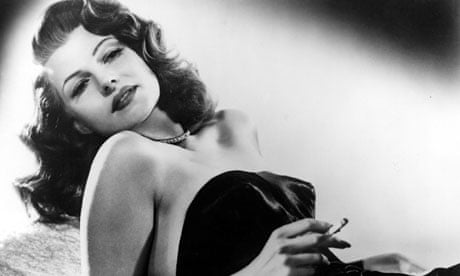In Charles Vidor's evergreen 1946 oddity Gilda – a studio-bound noir thriller that often feels more like an underlit musical comedy – the imperishable, impossible and irreplaceable Rita Hayworth reaches out across nearly seven decades of vanished time to prove that she still, with one extended little finger and a blunderbuss double-entendre, has the power to knock every man in the audience flat on his ass. "If I'd been a ranch," she coos at one point, "they'd have had to call me The Bar-Nothing."
Its plot is entirely McGuffinish and perfunctory, a loony mix of Casablanca, Sadie Thompson (a role Hayworth would play in the 50s) and Notorious. Think Buenos Aires, runaway Nazis, giant dice in the opening shot and musical numbers – all grafted on to a three-way melodrama of outrageous sexual provocation and emotional blackmail that's played like a minuet by scheming adventuress Hayworth and her two knock-kneed beaus (itinerant gambler Glenn Ford and scarfaced casino boss George Macready) on a gigantic, lavishly appointed set that amounts to a fantasia on mid-century Hollywood's notions of Latin-Americanness. If you can dream up a better backdrop for the first postwar movie of the second most lusted-after pin-up girl of the second world war, then go ahead, impress me, but I think Vidor – and his female writers and producer – had this one pretty well covered.
There are moments in Gilda – like the single-glove striptease that enlivens Hayworth's second rendition of Put The Blame On Mame, and much of the insanely ripe dialogue – when you suddenly understand why your grandparents used to say, "I preferred it when they kept their clothes on." Hayworth's nakedness is constantly trompe l'oeiled for a 40s audience by shoulderless gowns and diaphanous, breast-emphatic blouses. Howard Hughes was doing cruder, coarser, crasser things with Jane Russell's atomic décolletage over at RKO in the same period, but Russell had Bob Mitchum's face while Rita Hayworth was a Max Factor girl voted "Best Lips of 1945" and had charms, talents and splendours that far outweighed the contents of Russell's cantilevered brassiere. Thus it is she, not Russell, who anticipates the is-she-naked-or-isn't-she Marilyn Monroe of the no less provocative Some Like It Hot.
Rita Hayworth crops up in any number of great movies that I rarely think of as Rita Hayworth movies. Only Angels Have Wings and The Strawberry Blonde are my favourite movies that feature her (in both, she's the bombshell menacing the nice girl); and Gilda's doppelganger-movie The Lady From Shanghai – for which ex-husband Orson Welles hacked off her flame-red hair then bleached the remnants platinum blonde – was the movie in which she was at her most heartbreakingly beautiful. Gilda, though, is the greatest pure, undistilled Rita Hayworth movie – Bar None.
Gilda is at selected cinemas from Fri 22 July






Comments (…)
Sign in or create your Guardian account to join the discussion